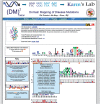Advances in translational bioinformatics: computational approaches for the hunting of disease genes
- PMID: 20007728
- PMCID: PMC2810112
- DOI: 10.1093/bib/bbp048
Advances in translational bioinformatics: computational approaches for the hunting of disease genes
Abstract
Over a 100 years ago, William Bateson provided, through his observations of the transmission of alkaptonuria in first cousin offspring, evidence of the application of Mendelian genetics to certain human traits and diseases. His work was corroborated by Archibald Garrod (Archibald AE. The incidence of alkaptonuria: a study in chemical individuality. Lancert 1902;ii:1616-20) and William Farabee (Farabee WC. Inheritance of digital malformations in man. In: Papers of the Peabody Museum of American Archaeology and Ethnology. Cambridge, Mass: Harvard University, 1905; 65-78), who recorded the familial tendencies of inheritance of malformations of human hands and feet. These were the pioneers of the hunt for disease genes that would continue through the century and result in the discovery of hundreds of genes that can be associated with different diseases. Despite many ground-breaking discoveries during the last century, we are far from having a complete understanding of the intricate network of molecular processes involved in diseases, and we are still searching for the cures for most complex diseases. In the last few years, new genome sequencing and other high-throughput experimental techniques have generated vast amounts of molecular and clinical data that contain crucial information with the potential of leading to the next major biomedical discoveries. The need to mine, visualize and integrate these data has motivated the development of several informatics approaches that can broadly be grouped in the research area of 'translational bioinformatics'. This review highlights the latest advances in the field of translational bioinformatics, focusing on the advances of computational techniques to search for and classify disease genes.
Figures



Similar articles
-
William Bateson, human genetics and medicine.Hum Genet. 2005 Oct;118(1):141-51. doi: 10.1007/s00439-005-0010-3. Hum Genet. 2005. PMID: 16133188
-
Sir Archibald Garrod and alkaptonuria -'story of metabolic genetics'.Clin Genet. 2005 Sep;68(3):199-203. doi: 10.1111/j.1399-0004.2005.00487.x. Clin Genet. 2005. PMID: 16098007
-
Insights into genetics, human biology and disease gleaned from family based genomic studies.Genet Med. 2019 Apr;21(4):798-812. doi: 10.1038/s41436-018-0408-7. Epub 2019 Jan 18. Genet Med. 2019. PMID: 30655598 Free PMC article. Review.
-
Lessons learned from additional research analyses of unsolved clinical exome cases.Genome Med. 2017 Mar 21;9(1):26. doi: 10.1186/s13073-017-0412-6. Genome Med. 2017. PMID: 28327206 Free PMC article.
-
Promoting synergistic research and education in genomics and bioinformatics.BMC Genomics. 2008;9 Suppl 1(Suppl 1):I1. doi: 10.1186/1471-2164-9-S1-I1. BMC Genomics. 2008. PMID: 18366597 Free PMC article. Review.
Cited by
-
Towards building a disease-phenotype knowledge base: extracting disease-manifestation relationship from literature.Bioinformatics. 2013 Sep 1;29(17):2186-94. doi: 10.1093/bioinformatics/btt359. Epub 2013 Jul 4. Bioinformatics. 2013. PMID: 23828786 Free PMC article.
-
Computational tools for prioritizing candidate genes: boosting disease gene discovery.Nat Rev Genet. 2012 Jul 3;13(8):523-36. doi: 10.1038/nrg3253. Nat Rev Genet. 2012. PMID: 22751426 Review.
-
An Integrated Data Driven Approach to Drug Repositioning Using Gene-Disease Associations.PLoS One. 2016 May 19;11(5):e0155811. doi: 10.1371/journal.pone.0155811. eCollection 2016. PLoS One. 2016. PMID: 27196054 Free PMC article.
-
MARS: leveraging allelic heterogeneity to increase power of association testing.Genome Biol. 2021 Apr 30;22(1):128. doi: 10.1186/s13059-021-02353-8. Genome Biol. 2021. PMID: 33931127 Free PMC article.
-
What is next after the genes for autoimmunity?BMC Med. 2013 Sep 4;11:197. doi: 10.1186/1741-7015-11-197. BMC Med. 2013. PMID: 24107170 Free PMC article. Review.
References
-
- Johannsen W. Om arvelighed i samfund og i rene linier. Oversigt over det Kongelige Danske Videnskabernes Selskabs Forhandlinger. In: Fischer G, editor. Erblichkeit in Populationen und in reinen Linien. Vol. 3. Jena; 1903. pp. 247–70.
-
- Farabee WC. Papers of the Peabody Museum of American Archaeology and Ethnology. Cambridge, Mass: Harvard University; 1905. Inheritance of digital malformations in man. In; pp. 65–78.
-
- Miki Y, Swensen J, Shattuck-Eidens D, et al. A strong candidate for the breast and ovarian cancer susceptibility gene BRCA1. Science. 1994;266:66–71. - PubMed
-
- American Medical Informatics Association. AMIA Strategic Plan. 2006. [(3 August 2009, date last accessed)]. http://www.amia.org/inside/stratplan/
Publication types
MeSH terms
Grants and funding
LinkOut - more resources
Full Text Sources
Medical

